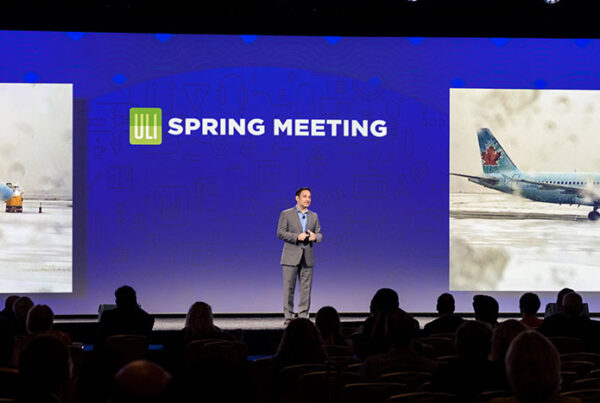
Just a few of the hundreds of apartment towers in the Greater Toronto Area of Canada. (Jesse Jackson/ERA Architects)
During the economic and population boom years of the 1960s, thousands of then-modern apartment towers were built in Canada. Predominantly privately developed, but supported by public planning policy and incentives, these towers shaped the urban and suburban landscape across the country—the Toronto region alone is home to 2,000 modern “towers in the park” complexes, generally standing eight stories or higher.
A half century or more into their service life, the need to retrofit and revitalize postwar towers has never been more critical. Compounding the growing inequities laid bare by the COVID-19 pandemic, much of Canada’s purpose-built rental housing is at risk and in need of renewal. However, retrofitting costs—as well as financing retrofits while maintaining housing affordability—continue to be a primary barrier.
Aging tower blocks are the backbone of the purpose-built rental sector in Canada, home to hundreds of thousands of households of modest and low incomes and often recent immigrants. As these buildings age, this affordable stock is threatened by two key factors: deterioration through neglect; and loss of affordability through investments targeted to raise rents.
The issue is not new. More than 10 years ago, the Tower Renewal Partnership (TRP) was formed to create a framework for tower neighborhood reinvestment. The TRP was initiated by ERA Architects as the Centre for Urban Growth and Renewal in 2009. The partnership was the Centre of Urban Growth and Renewal’s founding initiative. The initiative soon grew to include the United Way, the Maytree Foundation, Evergreen, and DKGI as core partners. Since then, the TRP has expanded to include dozens of supporters and contributors including the government of Canada (CMHC), municipalities, industry associations, tenant advocacy groups, and technical innovation leaders.
As the originators of the term tower renewal, the TRP saw the value in tower neighborhoods and fought for their preservation when many suggested outright demolition. Working as thought leaders and champions of this work, the term tower renewal is now ubiquitous and represents a strategy that promotes, supports, and directs enhancement and reinvestment in affordable apartment tower stocks across Canada. The tower renewal approach works in tandem to achieve quality-of-life improvements and realize public policy objectives related to climate change, affordable housing, poverty reduction, and economic development.
There is considerable international precedent to support a tower renewal–type approach in Toronto. Over the past 30 years, many European countries, including the United Kingdom, Germany, the Netherlands, and the Nordics, have implemented national retrofit programs targeting postwar apartment tower housing with positive results. Most importantly, these programs have introduced government-driven financial tools and programs to enable wide-scale retrofits, resulting in healthier citizens and a significant upward impact on economies.
To provide a fresh look at the current state of tower renewal in Toronto, ULI’s Advisory Services program put together a group of seven real estate experts from across the United States to visit Toronto in February 2020, tour tower neighborhoods, meet with dozens of stakeholders, and prepare a comprehensive and actionable set of recommendations on the challenge of maintaining affordability and resilience in the city’s private rental towers. In December 2020, ULI released a full report detailing how the city can retrofit aging towers to address climate issues while maintaining affordable rents. Recommendations included elevating the retrofit program within municipal government; developing a long-term housing strategy; building community resilience; balancing priorities of resilience, sustainability, and affordability; and accelerating uptake.
These recommendations offer a critical roadmap on which to build from existing programs, and importantly, innovate new planning and community structures for broad investment in large-scale tower neighborhoods to support social and economic life. Since COVID-19, the need to coordinate social and physical investment in these neighborhoods has only become more acute, and now is the time for renewed action.
In Canada, the TRP has worked with municipal, provincial, and federal governments to recognize the preservation of affordable housing as a key public policy priority. This has helped lead to the federal government’s National Housing Strategy Repair and Renewal Program, designed to enable tower renewal across the country through a $15 billion fund launched in 2017. The city of Toronto’s Tower and Neighbourhood Revitalization Unit, launched in 2008, has been the backbone of action and policy, framing Toronto’s response to resilient towers.
But more work is to be done to meet this challenge. Building from these programs, continued and heightened support for tower renewal is needed at all levels of government.
The Tower Renewal Partnership published several reports and written pieces this year including: COVID-19 policy response, retrofit industry acceleration and training, financing retrofits, tower infill potential, and conducting retrofits in occupied towers.
What Has Worked

The Ken Soble Tower Transformation is the first North American rehabilitation of a high-rise postwar apartment tower to the Passive House standard.
Already, a series of landmark projects are beginning to pave the way for industry-wide retrofits, showcasing the economic opportunity to the building industry as well as the improved climate resilience and housing quality that are possible on the ground. Furthermore, recent projects provide a lab in which to innovate deep retrofit design solutions, supply chain and product gaps, constructor ingenuity, and regulatory and building code opportunities.
Ken Soble Tower, 500 MacNab Street, Hamilton, Ontario
The Ken Soble Tower Transformation is the first North American rehabilitation of a high-rise postwar apartment tower to the Passive House standard. This net-zero-ready project reduces greenhouse gas emissions by over 94 percent and lays the groundwork for industry-wide, ultra-low-energy retrofits. Owned and operated by CityHousing Hamilton, the project is transforming 146 units of public housing for seniors to provide residents with improved comfort and control of their indoor environments and the ability to withstand extreme climate events into the future.
The Ken Soble Tower was in derelict condition, with demolition and replacement a likely outcome during project planning. The strategy of renewal resulted in a cost-effective alternative that, importantly, saved the substantial embodied carbon in the building’s concrete frame. The project consisted of an extensive renewal, inclusive of replacement and modernization of nearly all building electrical and mechanical systems; significant interior reworking for the accommodation of barrier-free units and community amenities; modernized direct in-suite ventilation system for COVID-19 resilience; and the environmental fitout to achieve the Passive House Standard. However, the project, at $36 million, costs an estimated 65 percent of the cost of demolition and replacement of the tower in new construction.
At 18 stories and more than 80,000 square feet (7,400 sq m), the Ken Soble Tower will be one of the largest EnerPHit-certified projects in the world. In meeting this certification, the total Energy Use Intensity (EUI) for space heating and cooling is less than 25kWh/m2 with the total project EUI anticipated to be less than 100 kWh/m2. Aging towers have an EUI of 300 to over 400 kWh/m2 and standard new towers have EUIs in the range of 200 to 300 kWh/m2. Moreover, aging towers produce, on average, more than 3.5 tons of carbon per unit. At Ken Soble, GHG emissions will be less than 0.35 ton per unit. In light of COVID-19, the project also provides fully modernized ventilation to suites, and in support of a senior population, is designed for aging in place with 20 percent of units fully barrier free, and reconfigured common and outdoor spaces designed to maximize community benefit. This project is slated for completion in 2021.Ken-Soble_Technical_Credit-ERA-Architects 
St. Hilda’s Seniors Care Centre, 2339 Dufferin Street, Toronto, Ontario
St. Hilda’s Senior Community Care is a three-tower senior’s community care center in Toronto’s west end. In 2017, with a rising vacancy rate and a declining state of repair, St. Hilda’s partnered with the city of Toronto to reinvest and renew these postwar towers with an ambitious $40 million campus-scale retrofit program. With over 400 units, this includes updating suites (new HVAC systems that deliver unitized fresh air, new kitchens and bathrooms, as well as overall upgrades for accessibility and comfort designed for aging in place), exterior site upgrades (accessible entryways, landscaping upgrades, garage roof repairs, accessible outdoor gathering spaces), and building upgrades (lobby and common space upgrades, elevator upgrades, and building envelope improvements including brick restoration, glazing, and fixing water leakage). Additional retail and expanded support services also are being explored as a possible phase 2. St. Hilda’s is an electrically heated building, and by virtue of Ontario’s clean grid, is 71 percent more carbon efficient than a naturally gas-heated building. While the St. Hilda’s project is primarily focused on resident health and comfort, it will also reduce energy loads and GHG emissions by a further 30 percent, and critically, through HVAC, fire suppression, and envelope upgrades, improve resident safety. Notably, the retrofit will be carried out without the need to relocate residents off site. By renovating tower by tower, residents will be temporarily relocated within the site. Furthermore, the retrofit will allow for seamless operation of shared ground-floor facilities, including commercial laundry, in-house nursing stations, and kitchen facilities.
What’s Next
While the COVID-19 pandemic has exacerbated inequities, forthcoming economic stimulus programs in Canada offer vital opportunities to accelerate reinvestment in tower neighborhoods across Canada. To maximize this opportunity, investments need to be calibrated to support demonstration projects and early adopters and build a robust retrofit industry. Building a strong retrofit economy will make retrofitting quicker and cheaper, increasing uptake of these types of projects. Further, provincial and municipal governments need to update regulations and building codes that will require late adopters to reinvest in their buildings without negatively affecting tenant rents.
“COVID-19 has brought housing inequities into sharp focus in neighborhoods throughout our cities. Implementing Tower Renewal strategies and investing in both the ‘hardware’ and ‘software’ needed, are more critical now than ever at a national scale,” said Graeme Stewart, director of the Centre for Urban Growth and Renewal and principal at ERA Architects.
In December, Canada’s federal government introduced a new climate plan intended to “cut pollution, make life more affordable, and create thousands of good jobs and new careers in construction, technology, manufacturing, and sales,” and will likely have an impact on tower renewal. To explore the implications of this climate plan on the real estate industry overall, ULI Toronto, ULI Alberta, and ULI British Columbia are bringing experts together from across the country for an upcoming ULI webinar. Register here for Canada’s Climate Plan: Implications and Opportunities for Real Estate and Development.
The ULI Advisory Services report offers recommendations based on expert observations and research. ULI members can access the report on Knowledge Finder and the Advisory Services website.



